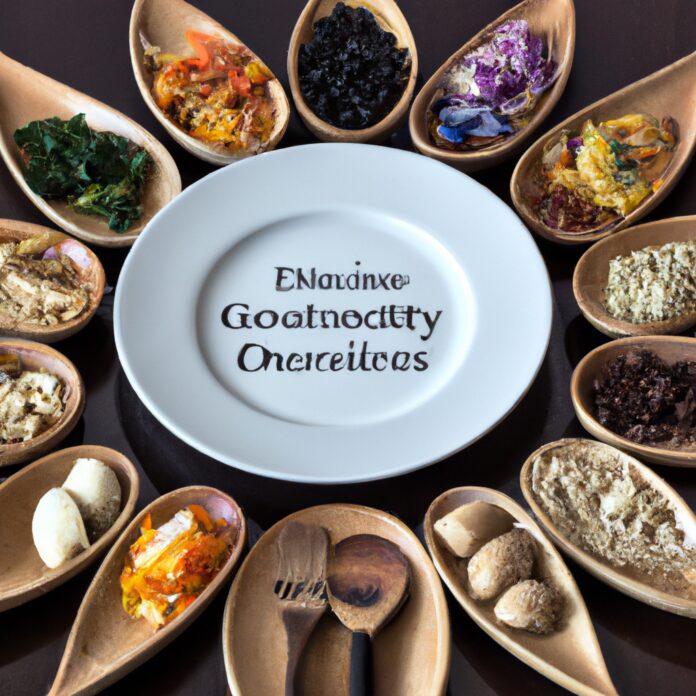It’s often said that food has the power to bring people together. While this may be true on a local level, it’s remarkable how culinary traditions from around the world can join us in unified celebrations of what makes us different – a concept known as global gastronomy. From exploring cultural diversity through traditional cuisines, to discovering the convergence of ingredients from far-flung places, let’s embark on a journey of global gastronomy, a place where everyone can expand their palates and minds alike.
1. Exploring Global Gastronomy: The Unifying Power of Culinary Traditions
For many of us, traditional food is at the heart of our identities and the cornerstone of our cultures. Global gastronomy is an opportunity to explore, understand, and appreciate the unique cultures and culinary customs of the world.
From delightful Mediterranean cuisine to delicious Mexican-style dishes, there’s something for everyone when it comes to international cuisine. Each person who experiences a signature dish from a new culture is getting a taste of the culture itself and developing an appreciation for it.
- Indian Spices. From black mustard seeds to cumin and fresh turmeric, Indian spices might be the most renowned when it comes to global gastronomy. Indians use a combination of many spices to bring out flavours and characteristics of their food that can’t be duplicated elsewhere.
- Italian Sauces. Italian food is known for its red sauces like marinara and bolognese. These sauces, along with pesto, help define the Italian culinary tradition of turning simple ingredients like vegetables and meat into something as unique as the country itself.
- African Stews. Hearty stews are a hallmark of African cooking. Ingredients like beef, tomatoes, onions, and peppers are combined with spices like turmeric and palms oil to create a thick and flavourful dish.
When it comes to global gastronomy, understanding the ingredients, the culture of the cuisine, and the historic dishes that give each nation its own identity, can make for an unforgettable culinary experience.
Rather than seeing the differences between culinary traditions, global gastronomy allows us to celebrate their similarities in the unbeatable unity of food. Whether you’re looking to travel or just wanting to enjoy an international meal from the comfort of your own home, exploring global gastronomy can open up endless possibilities to excite the taste buds.
2. Exploring Cuisine, Culture, and Tradition: The Power of Global Gastronomy
- Tastes of the World: Travelling allows us to experience and appreciate the unique flavors and ingredients from around the globe. From Latin America to Europe to the Middle East, each region has its own signature ingredients, cooking techniques, and fascinating cuisines. To get a true taste of a culture, there is nothing better than exploring the local food.
- Cooking with Local Ingredients: Exploring the local cuisine is like taking a journey through time.Traditional dishes can be enjoyed as they are made in their native regions: with the same ingredients, distinctive flavors, and distinctive cooking methods. Local markets and grocery stores offer a great opportunity to immerse yourself in the local culture and pick up components to try traditional meals in your own kitchen.
- Foodways and Celebrations: From Christmas dinner to religious occasions, food is often the centerpiece of celebrations. Eating certain dishes may represent a country’s or person’s culture and heritage. Food creates an opportunity to connect with others, including distant relatives, and to share special moments together.
- Bringing Together Communities: Food can be more than simply a source of sustenance. All around the world, international cuisine can bring together a wide variety of people and cultures. A shared meal can provide a glimpse into various cultures in the community, promote cultural understanding and foster appreciation for different world cuisines.
- Maintaining Traditional Foodways: Regional dishes can often reflect a place’s history, and many countries are dedicated to preserving their culinary heritage. Organizations, such as Slow Food, are devoted to supporting traditional foodways and encouraging people to appreciate and share the flavors of their local cuisine.
Global gastronomy offers an opportunity to explore the world and appreciate its many flavors. By traveling, shopping, and cooking locally, and by engaging with the culture and customs of different countries, we can discover the richness and diversity of international cuisines. Eating is a valuable bridge between cultures, and it is important to recognize and honor the unique culinary traditions and foodways around the world.
3. A Taste of Diversity: Connecting with People Around the Globe Through Gastronomy
Food has long been a way to cross boundaries and connect diverse cultures. In a time of increasing globalisation, the world’s gastronomic heritage truly speaks for itself. Across the planet, individuals of all backgrounds and ages try new cuisines, highlighting the dynamism of gastronomy as a platform to share moments, stories, and moments of friendship.
Gastronomy brings us together in the most unique ways. By combining elements from different regions, organic or international ingredients, as well as spices, chefs are able to come up with new flavours and dishes. Such a combination of ingredients reflects the diversity that lies beneath – the exuberance and variety that the world has to offer.
But gastronomy doesn’t just take us to faraway places through flavours, but also allows us to communicate with people through the act of sharing a meal. Through breaking bread with family and friends, new acquaintances, or even total strangers, we are connecting different cultures and learning about each other’s food practices. By doing so, we are allowing ourselves to explore and understand the world through the lens of different cultures.
At its core, gastronomy is about bringing people together in a way that goes far beyond the scope of the dinner table. Whether you’re cooking a dish from India, exploring a farmer’s market in Mexico, or sipping on some wine in Chile, it’s impossible to ignore the power of gastronomy to unify. It is through these experiences that our connections to the world become strong, and our knowledge of others deepens.
Gastronomy truly serves as a bridge between cultures. As a way to explore, share, and learn from those around us, it provides us with a unique insight to cultures around the world. Through its transformative power, it encourages us to venture outside of our comfort zones and to drive us to try and experience something new.
4. A Culinary Learning Journey: Gaining Insight Through Global Gastronomy
Gastronomy is unique to each culture around the world, and each cuisine offers a new insight and experience. Food is one of the best ways to gain understanding and knowledge of a place’s traditions and customs. You don’t need to be a professional chef to explore the world of gastronomy. Whether you’re a budding chef, food enthusiast, or a passionate traveler, a culinary learning journey is a great way to immerse yourself in global cuisine. Start your journey with these four steps:
- Pick a Global Destination: Choose a destination that heightens your interest and curiosity. Consider the culture, plants, and geology of the region to decide what gastronomic topics will be explored.
- Meet Local Chefs: When you arrive at your destination, search for local chefs with knowledge on traditional cooking techniques and ingredients as well as modern ones. Talk to them to get a deeper insight of food culture and their team’s approach to dishes.
- Eat! Well, of course. Connect with local restaurant owners, vendors, and grocers to try out different dishes and flavors. Focus on locally sourced ingredients to learn about the origin of ingredients and where to find them.
- Document Your Travel: One of the best ways to remember your journey is to document it through blog posts, photos, or even different recipes you create along the way. Use your blog, journal, and camera to keep track of your foodie discoveries!
Remember, your culinary learning journey is full of surprises. Be sure to stay open-minded and flexible to try new flavors, tastes, and techniques. And don’t worry if you find yourself lost. Ask locals, look up recipes online, and be brave to try something out of the ordinary. Food is an excellent way to understand a culture’s traditions, customs, and history — so get exploring!
Wander the markets, tour the farms, and go out with a local — the opportunities to learn about global gastronomy are limited only by your own imagination. Who knows what culinary secrets can be discovered on a culinary learning journey.
Global Gastronomy is more than simply a culinary journey – it’s a cultural experience like none other. By celebrating cultural differences and uniting through the common language of food, we celebrate diversity and create lasting memories that will stay with us for years to come. Let’s come together and continue to unite through the shared celebration of global gastronomy!



